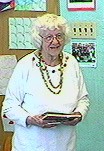Interview with Mrs. Knapp
 |
Mrs. Knapp was interviewed because she
went to a one room school house in Hilltown. She lived on a farm
and walked to school every day.
Mrs. Knapp came to visit the fourth grade class. She
informed us about one room schoolhouses in our community. One room schoolhouses
were used in our community |
until our school was built. One room schoolhouses
were not large in size. There were about thirty pupils in the
room. There was one teacher for 30-50 students at 8 grade levels.
Within the room there were desks and benches for students to sit
on. In the front of the room was the slate blackboard and a picture
of the president.
There were outside toilets (or out houses)
and no electric lights. They had slate blackboards. They had a
heater in the classroom that helped to keep the classroom warm
in cold months.
Students had to supply themselves with water.
They had a bucket which was carried by two people using a stick
to hold the handle. They often got their water at a local farm.
All students carried their own lunches to school. Lunches might
be an egg, jelly, or meat sandwich. Fresh fruit would only be
available when there was fruit on the trees or bushes at home
(they didn't have access to fruit because of a lack of refrigeration).
Summer vacation started at Memorial Day and
ended after Labor Day. The day went from 9:00 until 4:00. At 9:00
they said the Lord's Prayer. Then they sang a couple of songs.
During the school day, each grade level had a lesson. While others
had lessons, students practiced reading an assignment; then individual
students read in front of the class.
Some things that they played at recess were
tag, baseball, and hooper, which is tag with a stick. For punishment
they got their fingers hit with a ruler. Most students behaved
in school because they were taught to do this at home. Students
had to listen to what the teachers said.
Students often wore the same clothes more than
one day in a row. For example, they would wear the same outfit
on Monday, Tuesday, and Wednesday, and another outfit on Thursday
and Friday.
School was focused on learning. Activities
that students do at school today were not part of the daily learning
experience. They didn't have plays in school. They didn't really
go on field trips. Mrs. Knapp remembers being lucky to go on one
field trip to the zoo when she was young - they rode in the back
of an open truck to Philadelphia. She said such a trip was rare.
Students often had chores to do when they went
home.They might feed the calves or help around the farm in another
way. Most students went to high school for one year and it was
common to start work at 14. Mrs. Knapp went to work at 14. Some
went to work at 13. Mrs. Knapp indicated that the most common
job in the area was farming, but some went to work in the pants
factory.
Wages were much different for workers 50 years
ago. Mrs. Knapp also talked about the depression and how her father
earned only $40. a month as a school teacher - they were "glad
to get that", she said.
